Hoffman D.M., Singh B., Thomas J.H. (Eds). Handbook of Vacuum Science and Technology
Подождите немного. Документ загружается.

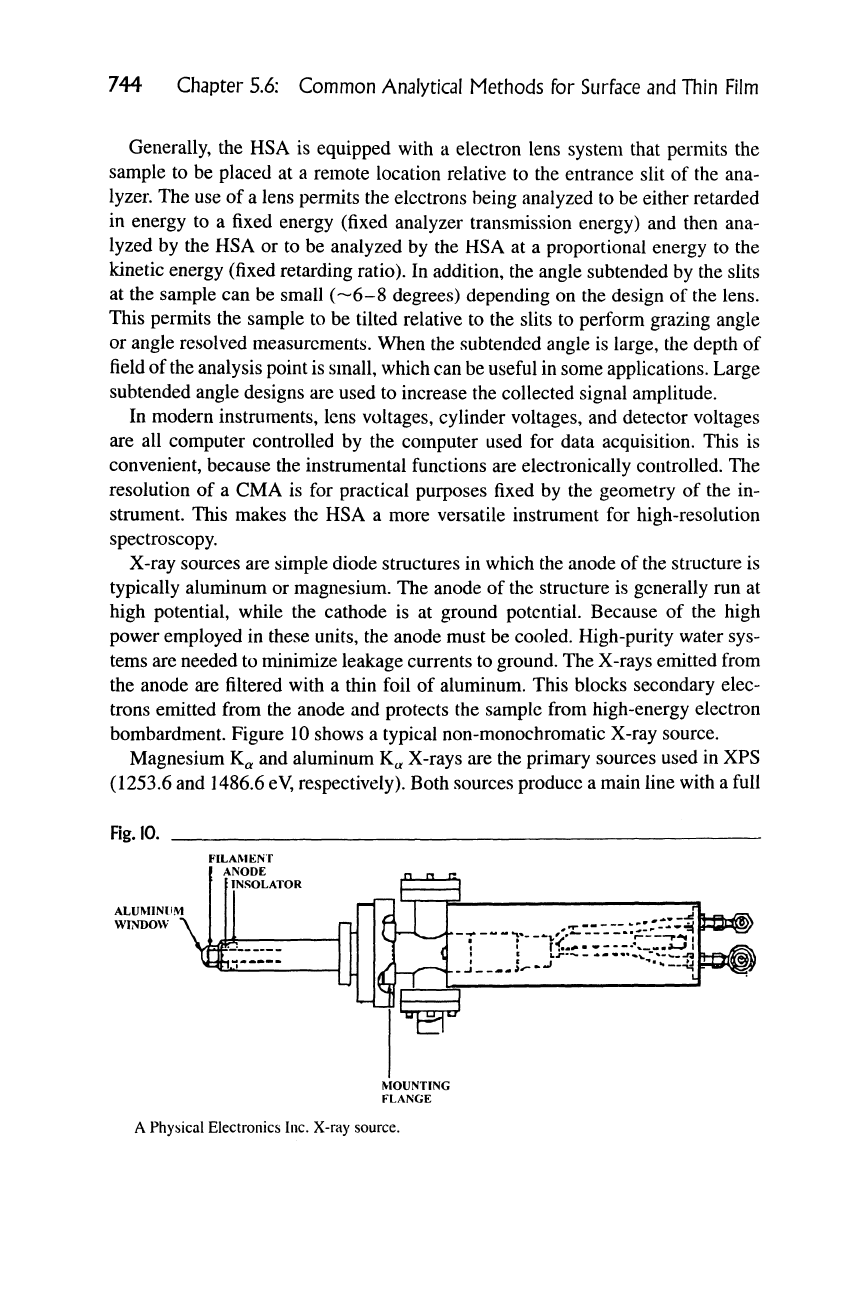
744 Chapter 5.6: Common Analytical Methods for Surface and Thin Film
Generally, the HSA is equipped with a electron lens system that permits the
sample to be placed at a remote location relative to the entrance slit of the ana-
lyzer. The use of a lens permits the electrons being analyzed to be either retarded
in energy to a fixed energy (fixed analyzer transmission energy) and then ana-
lyzed by the HSA or to be analyzed by the HSA at a proportional energy to the
kinetic energy (fixed retarding ratio). In addition, the angle subtended by the slits
at the sample can be small (—6-8 degrees) depending on the design of the lens.
This permits the sample to be tilted relative to the slits to perform grazing angle
or angle resolved measurements. When the subtended angle is large, the depth of
field of
the
analysis point is small, which can be useful in some applications. Large
subtended angle designs are used to increase the collected signal amplitude.
In modern instruments, lens voltages, cylinder voltages, and detector voltages
are all computer controlled by the computer used for data acquisition. This is
convenient, because the instrumental functions are electronically controlled. The
resolution of a CMA is for practical purposes fixed by the geometry of the in-
strument. This makes the HSA a more versatile instrument for high-resolution
spectroscopy.
X-ray sources are simple diode structures in which the anode of the structure is
typically aluminum or magnesium. The anode of the structure is generally run at
high potential, while the cathode is at ground potential. Because of the high
power employed in these units, the anode must be cooled. High-purity water sys-
tems are needed to minimize leakage currents to ground. The X-rays emitted from
the anode are filtered with a thin foil of aluminum. This blocks secondary elec-
trons emitted from the anode and protects the sample from high-energy electron
bombardment. Figure 10 shows a typical non-monochromatic X-ray source.
Magnesium K^ and aluminum K^ X-rays are the primary sources used in XPS
(1253.6 and 1486.6
eV,
respectively). Both sources produce a main line with a full
Fig.
10.
FILAMENT
ANODE
EINSOLATOR
A Physical Electronics Inc. X-ray source.
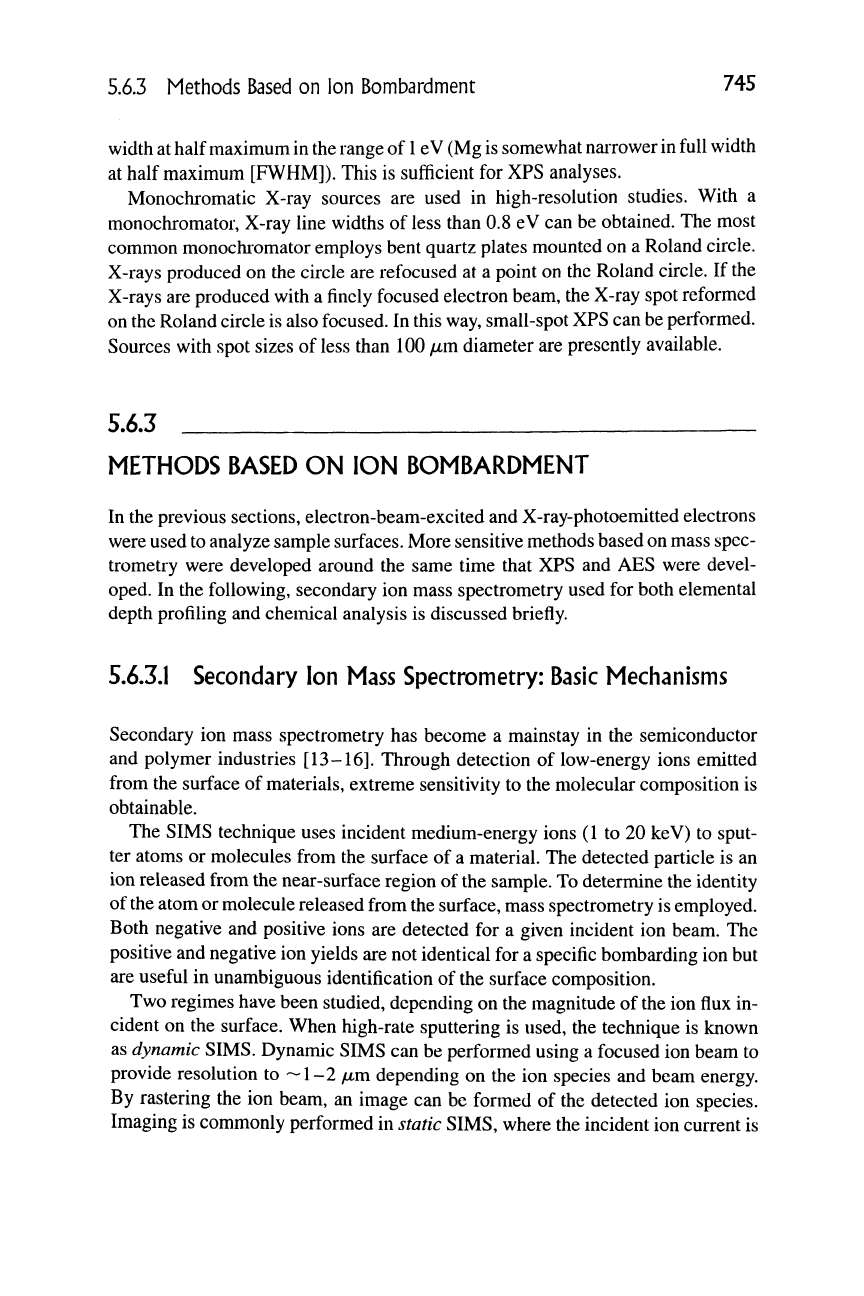
5.6.3 Methods Based
on Ion
Bombardment
745
width
at
half maximum in the range
of
1
eV (Mg is somewhat nairower
in
full width
at half maximum [FWHM]). This
is
sufficient
for
XPS analyses.
Monochromatic X-ray sources
are
used
in
high-resolution studies. With
a
monochromator, X-ray line widths
of
less than
0.8 eV can be
obtained. The most
common monochromator employs bent quartz plates mounted
on a
Roland circle.
X-rays produced
on the
circle
are
refocused
at a
point
on the
Roland circle.
If
the
X-rays are produced with
a
finely focused electron beam, the X-ray spot reformed
on the Roland circle is also focused. In this way, small-spot XPS can be performed.
Sources with spot sizes
of
less than 100
juLm
diameter are presently available.
5.6.3
METHODS BASED ON ION BOMBARDMENT
In the previous sections, electron-beam-excited and X-ray-photoemitted electrons
were used to analyze sample surfaces. More sensitive methods based on mass spec-
trometry were developed around
the
same time that XPS
and
AES were devel-
oped.
In
the following, secondary
ion
mass spectrometry used
for
both elemental
depth profiling and chemical analysis
is
discussed briefly.
5.6.3.1
Secondary
Ion
Mass Spectrometry: Basic Mechanisms
Secondary
ion
mass spectrometry
has
become
a
mainstay
in the
semiconductor
and polymer industries [13-16]. Through detection
of
low-energy ions emitted
from the surface
of
materials, extreme sensitivity
to
the molecular composition
is
obtainable.
The SIMS technique uses incident medium-energy ions (1
to 20
keV)
to
sput-
ter atoms
or
molecules from
the
surface
of
a material. The detected particle
is an
ion released from the near-surface region
of
the sample. To determine the identity
of the atom or molecule released from the surface, mass spectrometry is employed.
Both negative
and
positive ions
are
detected
for a
given incident
ion
beam.
The
positive and negative ion yields are not identical
for a
specific bombarding ion but
are useful
in
unambiguous identification
of
the surface composition.
Two regimes have been studied, depending
on
the magnitude
of
the ion flux
in-
cident
on the
surface. When high-rate sputtering
is
used,
the
technique
is
known
as dynamic SIMS. Dynamic SIMS
can be
performed using
a
focused ion beam
to
provide resolution
to ~ 1-2
/mm
depending
on the ion
species
and
beam energy.
By rastering
the ion
beam,
an
image
can be
formed
of
the detected
ion
species.
Imaging
is
commonly performed
in
static SIMS, where the incident ion current
is
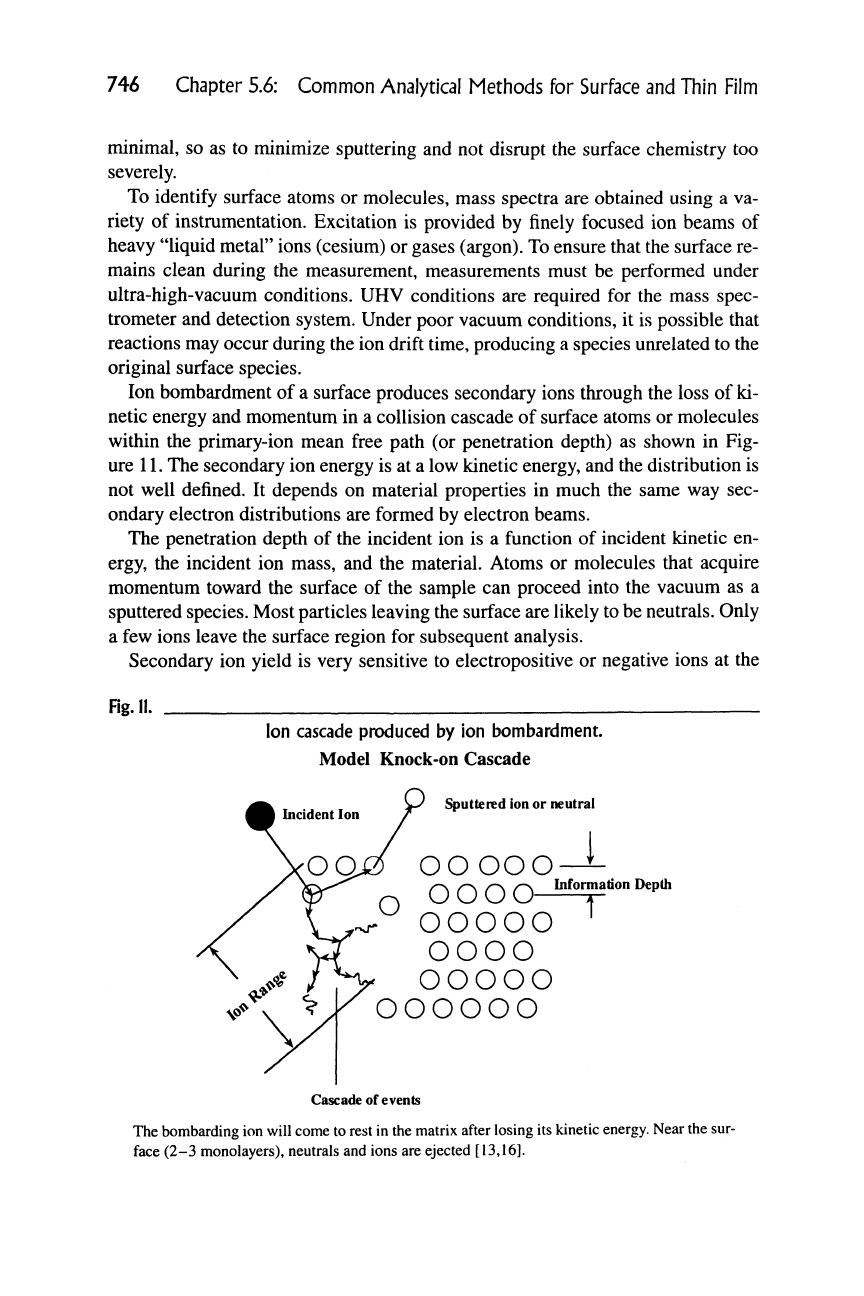
746 Chapter 5.6: Common Analytical Methods for Surface and Thin Film
minimal, so as to minimize sputtering and not disrupt the surface chemistry too
severely.
To identify surface atoms or molecules, mass spectra are obtained using a va-
riety of instrumentation. Excitation is provided by finely focused ion beams of
heavy "liquid metal" ions (cesium) or gases (argon). To ensure that the surface re-
mains clean during the measurement, measurements must be performed under
ultra-high-vacuum conditions. UHV conditions are required for the mass spec-
trometer and detection system. Under poor vacuum conditions, it is possible that
reactions may occur during the ion drift time, producing a species unrelated to the
original surface species.
Ion bombardment of a surface produces secondary ions through the loss of ki-
netic energy and momentum in a collision cascade of surface atoms or molecules
within the primary-ion mean free path (or penetration depth) as shown in Fig-
ure
11.
The secondary ion energy is at a low kinetic energy, and the distribution is
not well defined. It depends on material properties in much the same way sec-
ondary electron distributions are formed by electron beams.
The penetration depth of the incident ion is a function of incident kinetic en-
ergy, the incident ion mass, and the material. Atoms or molecules that acquire
momentum toward the surface of the sample can proceed into the vacuum as a
sputtered species. Most particles leaving the surface are likely to be neutrals. Only
a few ions leave the surface region for subsequent analysis.
Secondary ion yield is very sensitive to electropositive or negative ions at the
Fig.
IK
ion cascade produced by ion bombardment.
Model Knock-on Cascade
Sputtered ion or neutral
ooooo—L
^ ^ ^ /^ Information Depth
T
OOOOO
OOOO
OOOOO
oooooo
Cascade of events
The bombarding ion will come to rest in the matrix after losing its kinetic energy. Near the sur-
face (2-3 monolayers), neutrals and ions are ejected [13,16].
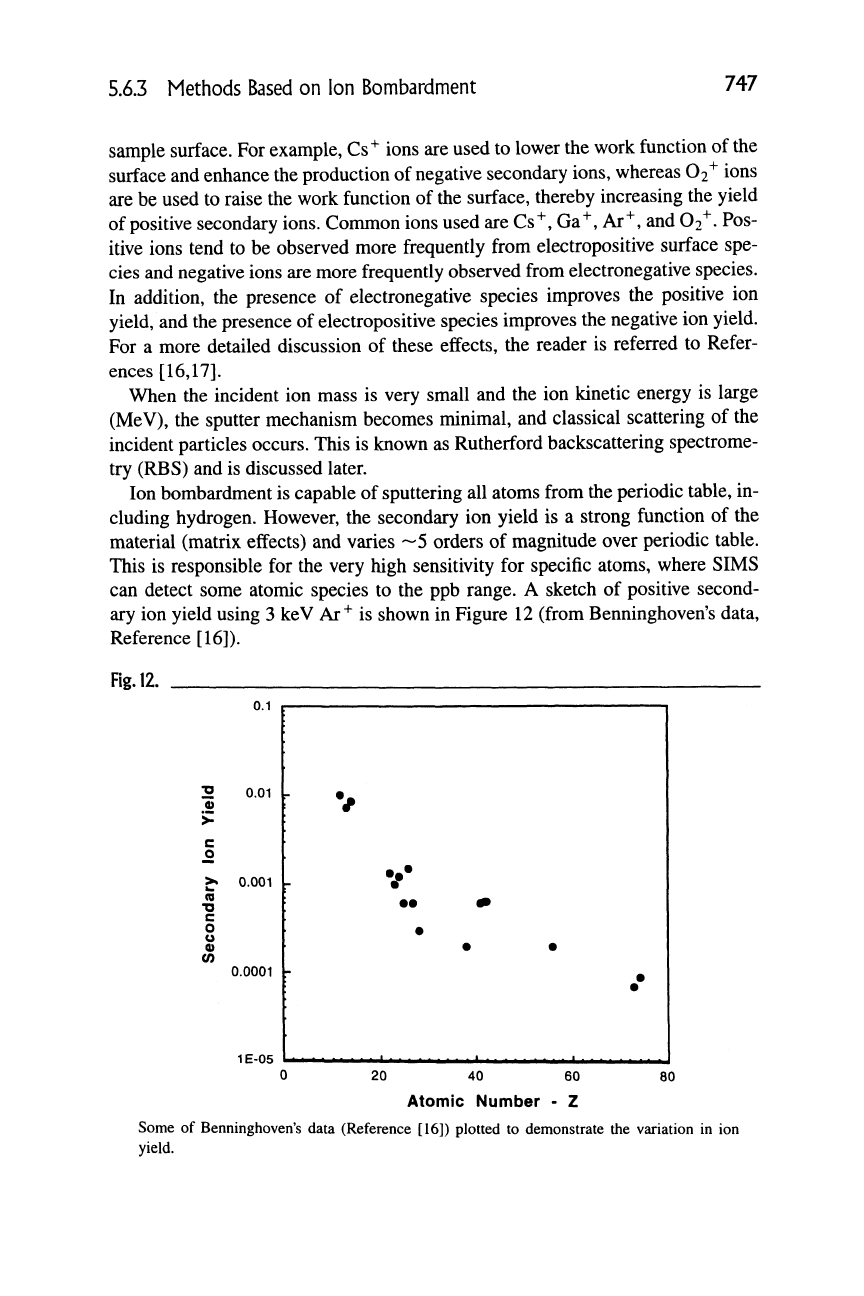
5.6.3 Methods Based on Ion Bombardment
747
sample surface. For example, Cs^ ions are used to lower the work function of the
surface and enhance the production of negative secondary ions, whereas
02"^
ions
are be used to raise the work function of the surface, thereby increasing the yield
of positive secondary ions. Common ions used are
Cs"^,
Ga"^, Ar"^, and 02^. Pos-
itive ions tend to be observed more frequently from electropositive surface spe-
cies and negative ions are more frequently observed from electronegative species.
In addition, the presence of electronegative species improves the positive ion
yield, and the presence of electropositive species improves the negative ion yield.
For a more detailed discussion of these effects, the reader is referred to Refer-
ences [16,17].
When the incident ion mass is very small and the ion kinetic energy is large
(MeV),
the sputter mechanism becomes minimal, and classical scattering of the
incident particles occurs. This is known as Rutherford backscattering spectrome-
try (RBS) and is discussed later.
Ion bombardment is capable of sputtering all atoms from the periodic table, in-
cluding hydrogen. However, the secondary ion yield is a strong function of the
material (matrix effects) and varies ^5 orders of magnitude over periodic table.
This is responsible for the very high sensitivity for specific atoms, where SIMS
can detect some atomic species to the ppb range. A sketch of positive second-
ary ion yield using 3 keV Ar"^ is shown in Figure 12 (from Benninghoven's data.
Reference [16]).
Fig.
12.
•o
"o
>
c
o
CO
C
o
o
Q>
CO
U.
1
0.01
0.001
0.0001
1E-05
-
• ^
/
V
••
•
«i
• •
Ill
•
•
20 40 60
Atomic Number - Z
80
Some of Benninghoven's data (Reference [16]) plotted to demonstrate the variation in ion
yield.

748 Chapter 5.6: Common Analytical Methods for Surface and Thin Film
Unlike the electron spectroscopies, SIMS is not considered an "inherently"
quantitative method. However, using appropriate standards in the dynamic mode,
SIMS can be very quantitative. In some of
the
early quantitation reported, samples
were implanted with the atom to be quantified. The implantation method yields a
quantitative amount of implanted atoms/cm^ (measured charge) and knowing the
implantation energy (measured accelerating potential), the ion penetration depth
can be obtained from tables [18]. Implants are Gaussian distributed to first order.
Consequently, the peak of the implant profile as determined from the standard
provides the concentration in a known matrix. This method is described in detail
in Reference [19]. SIMS can also provide isotopic information. For example, hy-
drogen and deuterium are readily separated by most spectrometers.
5.6.3.2 Instrumentation: Dynamic SIMS
Dynamic SIMS is used primarily for depth-profiling thin-film structures. In addi-
tion to the ion source, this instrument requires an ion extraction lens close to the
sample surface, a low-energy electrostatic energy analyzer, and a quadrupole mass
spectrometer or other mass spectrometer. Larger ion current densities must be
used to provide continuous sputtering, and in some cases very-high-rate material
removal (A per second) can be obtained using Cs, Ar, O, and Ga beams. The vari-
ous sputtering ions change the sensitivity and ion yield. The ion beam is rastered
over a region of interest on the sample surface, and the secondary ion signal is
raster gated in a smaller region to eliminate or minimize crater edge effects, as
shown earlier in the case of elemental depth profiling with AES. In this mode of
operation, very good depth resolution can be obtained over large film thicknesses
Ion signals are analyzed in a multiplex mode. Instruments are computer con-
trolled, and the computer sets the amount of time spent per mass channel. The re-
sulting profile is plotted as the number of counts in a channel as a function of
sputter time. As noted earlier, the counts scale can be changed into a quantitative
scale. The depth scale can be measured directly, using a surface stylus instrument
after the sample has been sputtered. Conversion to concentration versus depth is
therefore quantitative for simple materials systems.
Elemental depth profiling is generally performed over many thousand ang-
stroms of material. Depth resolution may be very material dependent. For ex-
ample, if the sample consists of palladium on silicon, it is likely that atomic mix-
ing will occur as a result of the cascade energy transfer during profiling. In this
case the depth resolution would be poor. Resolutions of less than 200A over a
depth of several tens of micrometers have been routinely achieved in other mate-
rial systems.
Dynamic systems have been used to study ion implantation profiles with sensi-
tivities over five orders of magnitude in crystalline materials such as silicon or
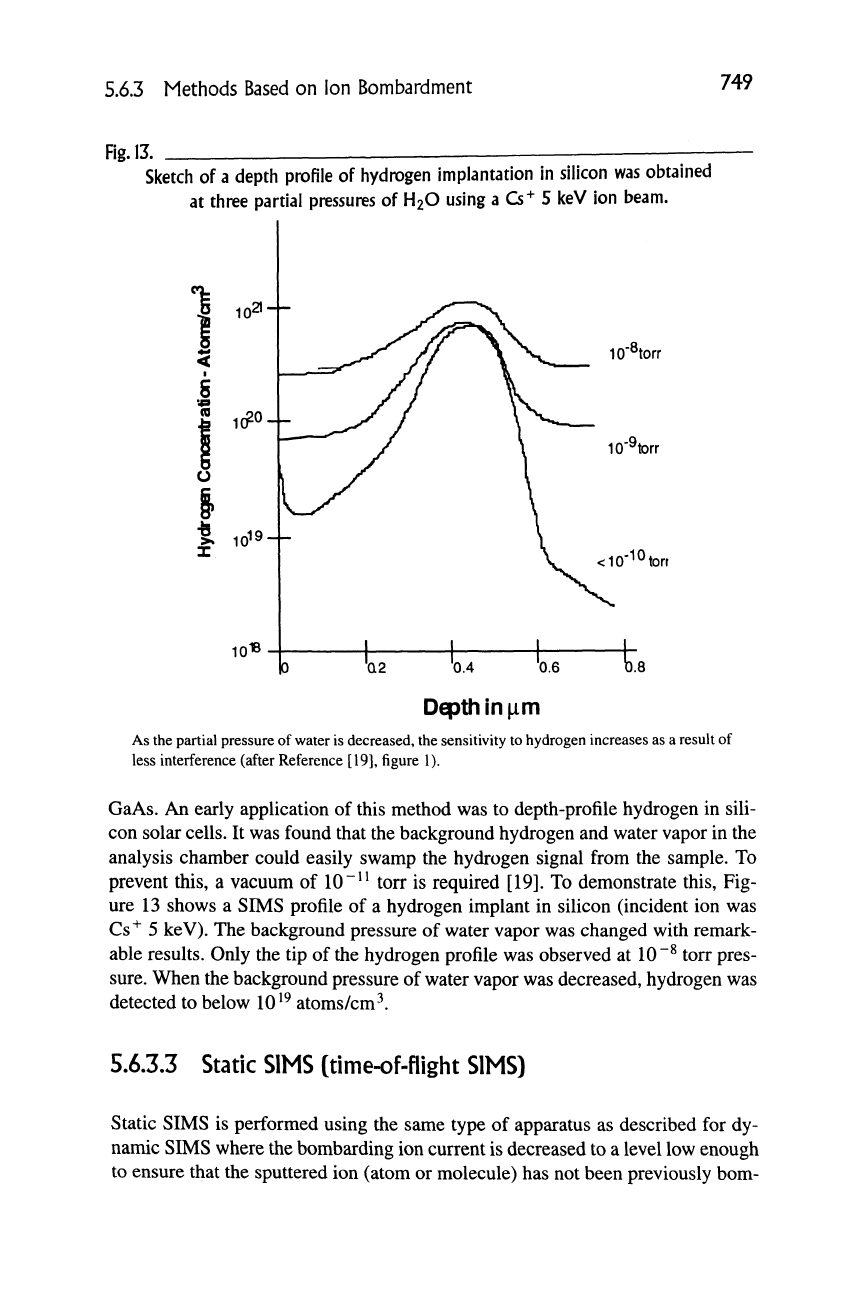
5.6.3 Methods Based
on Ion
Bombardment
749
Fig.
13.
Sketch
of
a depth profile
of
hydrogen implantation
in
silicon was obtained
at three partial pressures
of
H2O using
a
Cs"^
5 keV ion
beam.
lO'^torr
lO'^torr
Depth
in
|im
As the partial pressure of water is decreased, the sensitivity to hydrogen increases as a result of
less interference (after Reference [19], figure 1).
GaAs.
An early application of this method was to depth-profile hydrogen in sili-
con solar
cells.
It was found that the background hydrogen and water vapor in the
analysis chamber could easily swamp the hydrogen signal from the sample. To
prevent this, a vacuum of 10"^^ torr is required [19]. To demonstrate this, Fig-
ure 13 shows a SIMS profile of a hydrogen implant in silicon (incident ion was
Cs"^
5 keV). The background pressure of water vapor was changed with remark-
able results. Only the tip of the hydrogen profile was observed at 10"^ torr pres-
sure.
When the background pressure of water vapor was decreased, hydrogen was
detected to below
10
^^
atoms/cm^.
5.6.3.3
Static SIMS (time-of-flight SIMS)
Static SIMS is performed using the same type of apparatus as described for dy-
namic SIMS where the bombarding ion current is decreased to a level low enough
to ensure that the sputtered ion (atom or molecule) has not been previously bom-
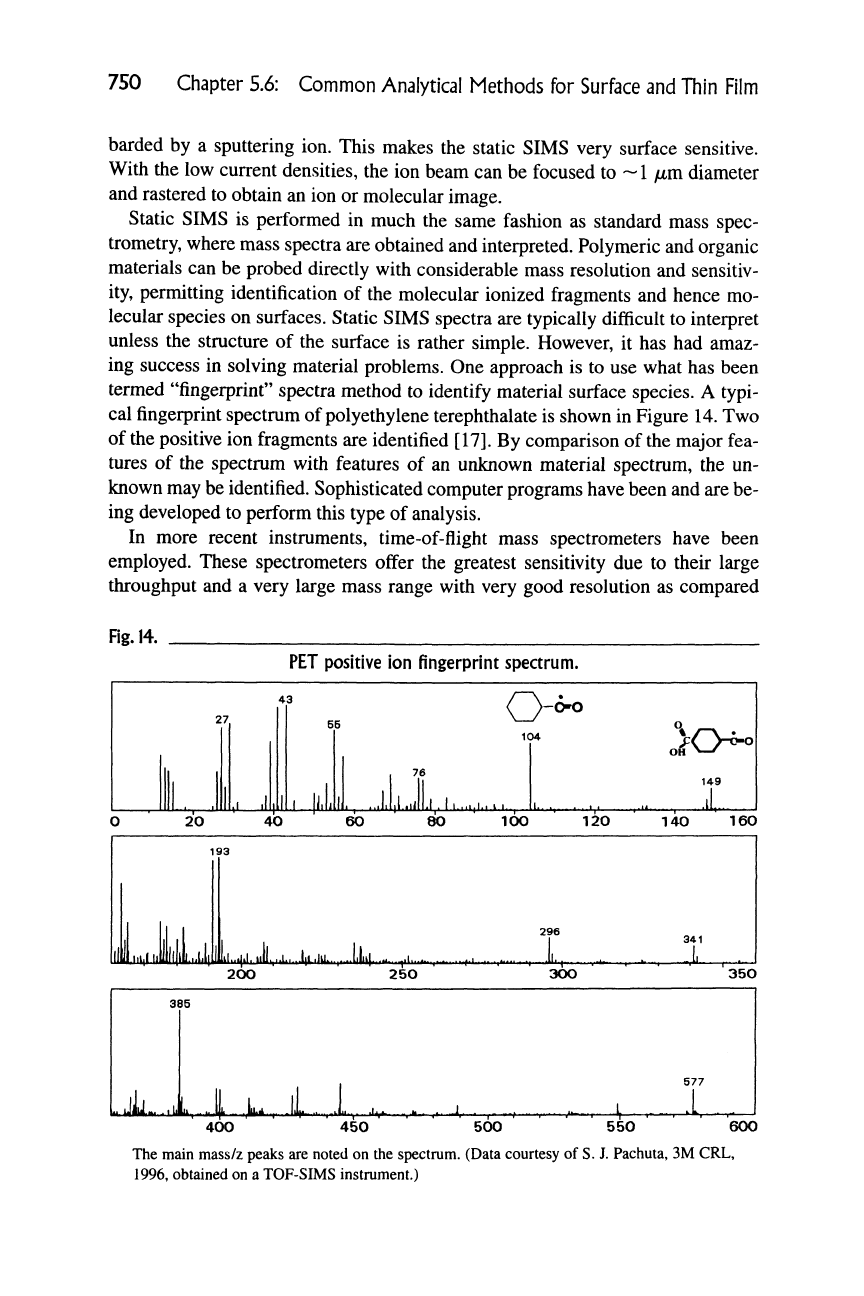
750 Chapter 5.6: Common Analytical Methods
for
Surface and Thin Film
barded
by a
sputtering
ion.
This makes
the
static SIMS very surface sensitive.
With
the low
current densities,
the ion
beam
can be
focused
to ~
1
/xm diameter
and rastered
to
obtain
an ion or
molecular image.
Static SIMS
is
performed
in
much
the
same fashion
as
standard mass spec-
trometry, where mass spectra are obtained and interpreted. Polymeric and organic
materials
can be
probed directly with considerable mass resolution
and
sensitiv-
ity, permitting identification
of the
molecular ionized fragments
and
hence
mo-
lecular species
on
surfaces. Static SIMS spectra are typically difficult
to
interpret
unless
the
structure
of the
surface
is
rather simple. However,
it has had
amaz-
ing success
in
solving material problems.
One
approach
is to use
what
has
been
termed "fingerprint" spectra method
to
identify material surface species.
A
typi-
cal fingerprint spectrum
of
polyethylene terephthalate
is
shown
in
Figure 14. Two
of the positive
ion
fragments are identified [17].
By
comparison
of
the major fea-
tures
of the
spectrum with features
of an
unknown material spectrum,
the un-
known may be identified. Sophisticated computer programs have been and are be-
ing developed
to
perform this type
of
analysis.
In more recent instruments, time-of-flight mass spectrometers have been
employed. These spectrometers offer
the
greatest sensitivity
due to
their large
throughput
and a
very large mass range with very good resolution
as
compared
Fig.
14.
PET positive
ion
fingerprint spearum.
31
to, JLLni .ly
200
J5
L,..M,.1L
JUJU
.il
250
LUY*
iLph^
.,.ii..
,
..
J
300
"t
1 1**-—r
_L_
577
350
400 450 500 550
600
The
main
mass/z
peaks
are
noted
on the
spectrum.
(Data
courtesy
of S. J.
Pachuta,
3M CRL,
1996,
obtained
on a
TOF-SIMS
instrument.)
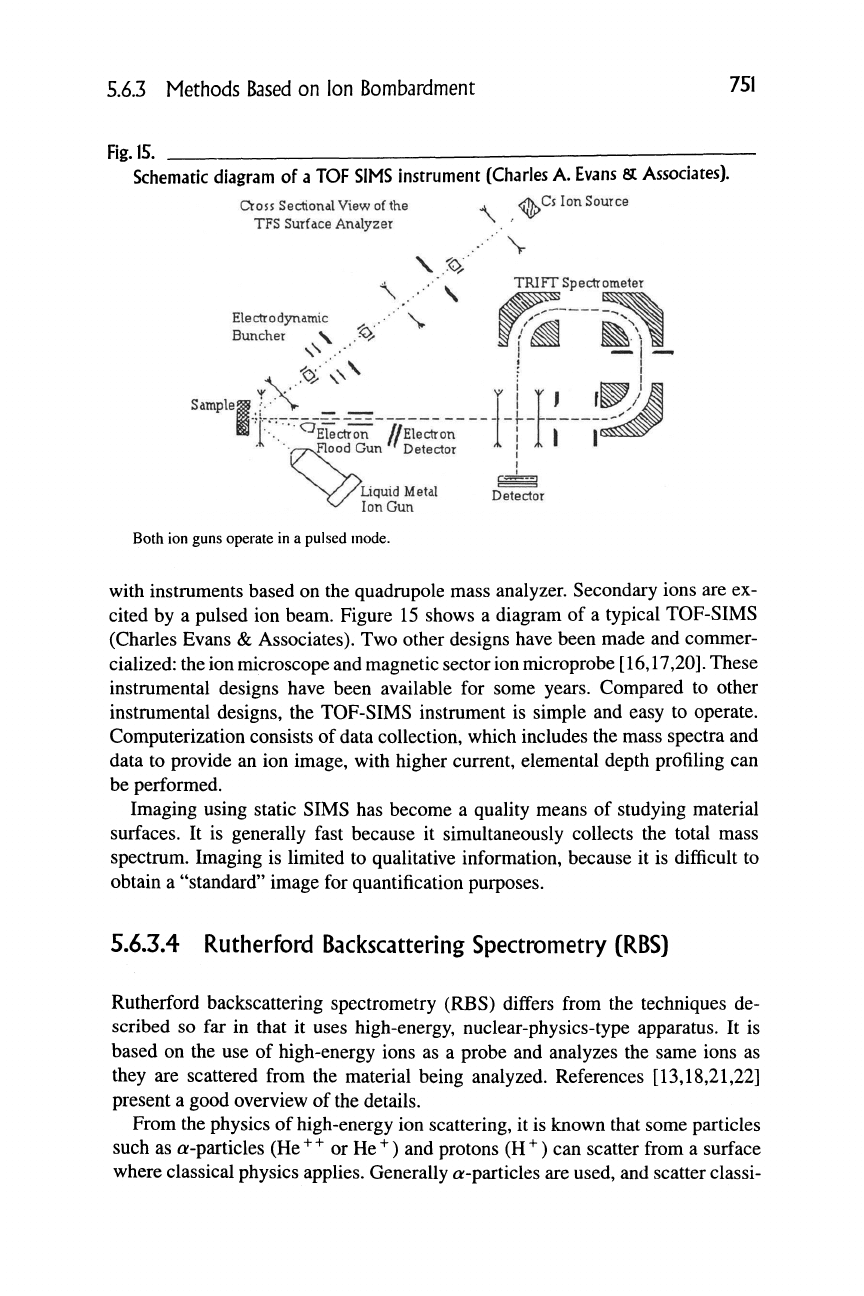
S.63 Methods Based
on Ion
Bombardment
751
Fig.
15.
Schematic diagram of a TOF SIMS instrument (Ciiaries A. Evans
6C
Associates).
<ffls^^
Ion Source
-
v
TRIFT Spectrometer
Cro J
J
Sectional View
of
the
TFS Surface Analyzer
\
Electro dynamic
Buncher
V
,
• • \
Sample
O
Electron /^Electron
flood Gun
'
Detector
Liquid Metal
Ion Gun
Detector
Both ion guns operate
in a
pulsed mode.
with instruments based on the quadrupole mass analyzer. Secondary ions are ex-
cited
by a
pulsed ion beam. Figure
15
shows
a
diagram
of a
typical TOF-SIMS
(Charles Evans
&
Associates). Two other designs have been made and commer-
cialized: the ion microscope and magnetic sector ion microprobe [
16,17,20].
These
instrumental designs have been available
for
some years. Compared
to
other
instrumental designs,
the
TOF-SIMS instrument
is
simple
and
easy
to
operate.
Computerization consists
of
data collection, which includes the mass spectra and
data
to
provide
an
ion image, with higher current, elemental depth profiling can
be performed.
Imaging using static SIMS
has
become
a
quality means
of
studying material
surfaces.
It is
generally fast because
it
simultaneously collects
the
total mass
spectrum. Imaging
is
limited
to
qualitative information, because
it is
difficult
to
obtain
a
"standard" image for quantification purposes.
5.6.3.4 Rutherford Backscattering Spectrometry (RBS)
Rutherford backscattering spectrometry (RBS) differs from
the
techniques
de-
scribed
so far in
that
it
uses high-energy, nuclear-physics-type apparatus.
It is
based
on the use of
high-energy ions
as a
probe
and
analyzes
the
same ions
as
they
are
scattered from
the
material being analyzed. References [13,18,21,22]
present
a
good overview
of
the details.
From the physics
of
high-energy ion scattering,
it
is known that some particles
such
as
Qf-particles (He"^"^
or
He"^) and protons (H"^) can scatter from
a
surface
where classical physics applies. Generally a-particles are used, and scatter classi-

752 Chapter 5.6: Common Analytical Methods for Surface and Thin Film
cally in the range of
1
-3 MeV (10^ eV). This means that when an a-particle scat-
ters from an atom at the surface of a material, both the energy and momentum are
conserved (2 E and S mV = 0).
Classical scattering implies that a-particles scatter in a "billiard ball" fashion.
To simplify analysis, a scattering event of 180 degrees relative to the incident
beam is employed to identify the surface scattering atom(s).
At the surface of the sample, the energy of the a-particle is given by
I -
MM.
(M, + M,y
(I - cos 0) where <9« 180°
(2)
El is the scattered energy, E^ is the primary energy, and M^ is the unknown mass.
Equation 2 reduces to
[(M^
—
4)/{M^
+ 4)p at 180°. By comparing the energy of
the backscattered a-particle to the primary beam energy, the scattering atom can
be identified. The ratio of
E^/EQ
is known as the kinetic factor and is tabulated
[18,21].
Elemental sensitivity depends on the Rutherford scattering cross section,
which, for 180-degree scattering, is simply
da
'da
= 4(Z,Z,e2/4£o)'
(3)
where e is the electron charge (1.6 X 10~^^ coulombs),
EQ
is the beam energy,
and Z is the atomic number. This expression becomes somewhat more complex
when 0 ^ 180°. An example is shown in Figure 16, where a very thin layer of sil-
Fig.l6.
A typical
RBS
spectrum.
Energy MeV
2,0
1.5
1.5
2.0
1.0 H
0.5
0.0
200 300 4-00
Channel Number
500
The spectrum was obtained from a very thin layer of silica on a carbon substrate.

5.63 Methods Based on Ion Bombardment 753
ica was deposited on carbon. The Si and O peaks correspond to E^ as computed
from Equation (3). The silicon and oxygen peaks are well separated out but are
not very intense, as explained by Equation (4). The relative sensitivity becomes
greater as the atomic number is increased and ranges two orders of magnitude over
the entire periodic table. However, the ability to resolve the unknown energy be-
comes less as Z increases or sensitivity increases.
Thin-film analysis is possible because the a-particles scatter from atoms be-
neath the surface of a film. The a-particles lose energy, dE/dx, where x is the
depth into the film, as they travel through the thin film (the energy loss occurs pri-
marily through electron interactions). The energy loss is a function of the mass of
the target and is known as the stopping cross section or power. dE/dx is presented
in a computed table as a function on particle energy and the atomic number of the
scattering atom. The units are presented in eV • cm-/10'^ atoms, and hence the
depth scale for thin-film data is a function of the atomic density of the material.
Film thickness determination is reasonably accurate and given sufficiently power-
ful software, the raw data can be directly converted to an elemental depth profile.
By performing a forward scattering experiment where the a-particles are per-
mitted to strike the sample surface at a shallow angle, the scattered a-particles
can be filtered out using a thin aluminum window and a particle detector placed in
line with trajectory of the a-particles. This system will collect protons knocked
out of the solid by the incident a-particles. The a-particles do not hit the particle
detector but the protons can easily traverse the aluminum window and be col-
lected. This is known as forward recoil scattering (FReS) and is used in obtaining
hydrogen depth profiles.
As the beam energy is increased, y-rays are generated. They are the result of
the a-particles interacting with the nuclei of the atoms. The y-ray is elemental
specific and is produced at a very specific incident kinetic energy. As a result,
since the a-particles lose energy to the material system, a pseudo depth profile can
be obtained by varying the incident beam energy and plotting the y-ray yield as a
function of energy loss that is converted to depth. The yield can be converted to a
quantitative elemental concentration.
INSTRUMENTATION
The apparatus required to perform RBS and FReS (forward recoil scattering), is
shown in Figure 17. The main portion of the system is the ion accelerator. This
system electrostatically accelerates ions to a potential of < 4 MeV. The ion en-
ergy is determined by the accelerating voltage applied to the accelerator. He ions
are accelerated up to
1
MeV and then stripped of electrons to produce either He
"^
or He^"^. The He"^ ions are accelerated to ground potential, dropping 1 MeV. In
the case of He^^, the alpha particles obtain a potential of 2 MeV accelerating to
